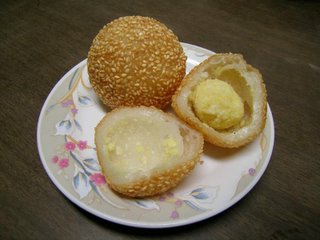
Bánh Cam and Bánh Rán are often confused as one which is not hard to understand since the two are extremely similar. The only differences are bánh cam is from the southern region of
For the Outer Pastry:
-1lb glutinous rice flour
-100g rice flour
-2 tsp baking powder
-200g sugar
-400g water
-75g potato
-1 tsp oil
-sesame seeds
*Peel, steam and mash potato. Mix together flours and baking powder. Boil together sugar and water and pour into flour mixture (while still hot, right off the stove). Use a wooden spoon to mix together flour and syrup so that the flour soaks in all of the syrup. Let mixture cool enough to handle before kneading in potato and oil to make a smooth dough (dough will be sticky).
Filling:
-100g mung beans (peeled and split)
-100g sugar
-50g grated coconut
-2 tbs oil
-1 tsp
*Rinse, soak, cook and mash beans. Mix in sugar and oil. Stir fry over medium heat until thickened add coconut and
Making the Pastries:
Wet hands with water, and grab some dough, flatten it and wrap filling in the middle. Roll in sesame seeds. Deep fry over medium heat until golden and puffy (about 15 mins).
Note:
To make Bánh Cam:
>>Omit
>>Omit potato when making “outer pastry dough”
>>Reduce sugar in “outer pastry dough” to 150g
>>Dough does not need to be made with boiling water, warm water is just fine, add water slowly and knead to form a smooth dough (you’ll need less water).
1:22 PM |
Category: |
24
comments







Comments (24)
Hi tt. I think this look really good, even though I can't eat more than one at a time. I'm having a little difficulty with the gram measurements for all your recipes. I usually buy all the flour in a 1 lb bag=454grams. When you say 300g, 100g, 50g, I don't really know how many cups that is. Is it possible that you note it next to the ingredient how many cup that is? There's only a few type of flour that we use. Is it possible to tell me just that for the few flour and sugar...and I'll figure the rest? I need to know glutinous rice flour, rice flour, tapioca starch, bread flour, 100 g sugar, 100g water. Thanks a lot. I really appreciate your help and posting the recipe.:)
There is no accurate way to measure in volume. Read the comments to this post and you'll see why. http://pwmf.blogspot.com/2006/02/bnh-tiu-hollow-doughnuts.html
I suggest you invest in a scale they're very handy and only costs around $5.
Hi tt. I understand, but I only want to know the measurement for these flour since I don't have a scale yet. A scale for only $5, where can I get them? I never use one before...If I know how many cups is 300g, then I can figure the rest, but if you don't know, I'll have to wait until I find a scale. Thanks.
Anonymous,
You can buy a scale anywhere that sells household appliances. 300g of what? Everything has a different weight so there is not “direct” conversion. For example sugar is heavier then flour so 300g of sugar can equal 2 cups while 300g of flour can equal 5 cups.
Hi tt. Per my previous conversation I asked about 300g of rice flour, glutinous rice flour, tapioca flour, bread flour and also how many cups is 100g of sugar. Thanks
Anonymous,
If you look at the flour packages, you can use the information they give you to convert from grams to cups. For example a package of tapioca starch is 400g, so measure out the starch using a measuring cup to find how many cups 400g is. Then divide that number by 4 to know how many cups 100g is, if you want to know how many cups 300g is then multiply by 3 (after dividing by 4); that will give you the answer to how many cups of tapioca starch is 300g. You can use this method for all other flour and sugars too.
On some packages, like my package of bread flour, it says on the nutrition label a serving is 1/4 cup which is 30g. So multiply 30g by 4 to know the weight of 1 cup.
When converting ingredients such as sugar or salt, which is usually measured by tsp or tbs in the nutrition label; keep in mind 3 teaspoons = 1 tablespoons, 16 tablespoons = 1 cup.
Hi tt. I did that before but wasn't sure if it work that way or not. But I will do so again. Thanks.
Why weren't you sure that it could work that way? There is logic to everything.....
hi tt, great website! you seem to not only have a vast array of vietnamese recipes but chinese as well. very impressive. there are a couple of dessert recipes that i have been trying to find but, not knowing their names, have not been successful. i was wondering whether you could help.
1) the green jellies in che ba mao
2) chinese glutinous rice balls w/ peanuts and sugar in the center, covered w/ coconut shreds
3) little ice cream balls wrapped w/ something (i think it's japanese)
any help would be greatly appreciated. thanks!
thanks for stopping by, glad you enjoy my recipes.
1) recipe for jelly: http://pwmf.blogspot.com/2005/10/ch-thch-sen-lotus-seed-and-jelly.html
2 & 3) I think you're talking about bánh bao chỉ aka mochi. The "skin" for both is the same the only difference is the filling.
thanks for your jelly link but i don't think that's it. you use agar agar which is pretty firm. the jellies i'm talking about look like worms and they are soft. perhaps restaurants in different regions use different things? thks anyways. i will definetely look up mochis. thks again.
if you want a softer jelly just reduce the agar agar/increase liquid.
Hi, I love your site, it's so great. I was wondering if you knew how to make the banh cam duong, i think it's called. It's kind of the same as this recipe, but it's flatter and has crunchy sugar on top and doesn't have any sesame seeds. I'd greatly appreciate the help. Thank you.
I saw another recipe about "banh cam" which has 1 main ingredients(glutinous flour) while yours has more than 3. I'm wondering whether it makes any difference? Thanks.
YOU ARE A LIFE SAVER!!! I am a graduate student and recently moved out and your page is wonderful! thanks!
em, NA
Hi TT,
Thank you for a great site! I tried making this once, don't exactly recall the ingredients but when I fry them, they explode out of the frying pan. It was so scary, almost got burn from the hot oil splashing from the explosion. Has this happen to you or anyone else trying this recipe?
hi...i was wondering if u know how to make the thai dessert called Khanom Tang Tak in english it means poorman's pancake? if u do know, plz plz tell me how to make it...if u don't know that's okay.
dreamer
sorry I don't know what Khanom Tang Tak is ...describe it?
Hi, I came across your blog the other day while googling "banh cam." You have so many recipes that I have been searching for. Your blog is great! I actually made the banh cam tonight. I found all the ingredients in the Vietnamese grocery store. Your recipe tastes exactly like the ones they sell in the store. The only problem I came across is that I had a hard time sealing the ball so that it was uniform all around. Where I sealed it, it had extra dough and then when I cooked it, it was heavy on one side and it wouldn't turn golden brown all around. I just had to hold it down to one side while cooking it. It didn't turn out exactly round, but tasted just like it. Thanks!
hi tt,
i enjoy reading your blogs. to help with a question from Anonymous about the green jelly like ... i think that was the "banh lot" which made from cooked rice flour pressed through a mold with holes. this mold set on top of a water bowl to catch the droppings from the pressing dough and for this droppings,it knows in vietnamese as "lo.t" therefore, it where the name "banh lot" came about. oh it's green because pandan extract.
someone wanted to know what the jelly wormy green thing in che ba mau. its is called Banh Loc. It is made with chestnut flour. The box has instructions on how to make it. It will come out clear, but you can add food color to make it green.
Doesn't appear that you update this blog anymore, but I'd love to know how to make the ball so round, and hollow enough for the filling to bounce around inside.
would you please tell me how to make salty one ( banh ran man)
Here is my receipe
dough:
160z of glutinous flour which equal to 1 bag.
2 to 2 1/2 cup of rice flour (rice flour is for how crunchy you wants your banh cam to be.
1cup of sugar
2 1/2 warm water if needed add more slowly.
2-1/2 tbs baking powder which equal to 1pkg of Alsa Brand baking powder (found in most asian store)
1cup of instant mash potatoes or fresh potatoe (prevent dough from exploding)
fresh potatoe need to be boil and mash it with dough
before frying the dough it need to rest for 1 hour. This will also help it to not explods